Five women greeted us with wide smiles, kissing us on each cheek. We sat down in a humble room and started to ask them how their businesses were doing, how their lives were going. The last few days have marked the first date of repayments for the Arusha Project microfinance project. Out of ten groups, six have repaid us promptly and some individuals have opted to repay a larger sum than required – a very good sign for the future of the fledgling project. Loans last six months with monthly payments so that borrowers are not faced with the substantial task of coming up with one large repayment at the very end of the period.

After warm introductions, Cheryl pulled out a survey that the women are asked to complete each month along with their monthly repayments. Questions cover HIV status, family status, income, and food consumption patterns. This is our way of tracking the success of the microfinance project. If a woman decides to get tested or has a family member tested, if she is able to buy chicken for dinner, and if her monthly income rises, then we will be satisfied that the project has enabled our borrowers to improve their standard of living, which is the ultimate goal.
The women smile and laugh as Cheryl asks in Kiswahili, how often do you eat sukumoiki? Everday. Ugali? Everyday. Chapati? Once a week. Chicken? Once a month. These women are poor, but they do have their own businesses, selling parachichi (avocados), ndizi (bananas), used clothes, or roasted corn, that the Arusha Project loan has helped jumpstart or reinforce. Cheryl tells them they are strong women and they are thankful, for the loan and the trust we give them. They feel empowered, you can tell in their eyes.
For the most part, repayments were a very encouraging experience and Cheryl is excited for the future of the project based on the positive responses she has received so far. However, this doesn’t explain those who defaulted on their monthly repayment. This explanation dates back to the issues we faced on the day we gave out loans. Previously, I explained that some women came without IDs and had their organization leader vouch for them. The majority of these women without valid IDs came from three groups associated with TUPO. Although circumstances seemed very questionable that day, and the women seemed less than confident in their claims, the Arusha Project conceded to giving the women loans based on good faith and previous professional relationships with the leaders of TUPO. Before the loans were given out, Cheryl asked each woman to state the type of business they had described in their loan application so that we could later cross-reference the information with the actual applications we had received. The next day, Cheryl found clear discrepancies between the women’s claims and the paper evidence in two of the TUPO associated groups, showing that the women we had given loans to were not the women that had applied for the loan the week prior. Since then, we have cut off all work and events we have planned with TUPO, including a soccer match, and asked for the entire loan back without interest. Currently TUPO claims that the women had already invested the money and will not be able to pay back the loan for another month. Because this is not an issue we want to take to court, the Arusha Project has again conceded and is in the process of creating another contract for TUPO in which the women will repay the entire sum of the loan without interest in one month from now.
We hope for the future of TUPO, an organization that we still think has good message and good membership, yet questionable leadership, and the future of our loan program, that the issue will soon be resolved. Until then, we are optimistic about the beneficial impact the loans will have on the lives of the altruistic women we have reached.
– Kaia
The barren landscape gave way to winds that stirred up dirt devils in fields beside our car. The dirt and dust was noticeably lighter, a deceiving sand color, and made the local Maasai in their colorful red and blue robes stand out against the flat backdrop of the land. Patches of bright green marked distinct areas of corn and sunflower seed crops set in between unusually square Maasai bomas. As we neared the mining town of Merarani the landscape changed to one of purely dirt and dirt houses, shops, markets
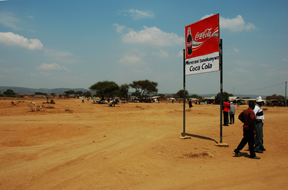
It was Sunday, the miners’ day off, and people lined the streets in a manner similar to Arusha town but much more quiet and rural. Past the town we drove through flats that had been dug to look like a minefield. Everywhere, workers had set up makeshift shacks made out of plastic and canvas bags on simple wood frames. This was the free area, anyone could mine there, and many people did, but only smaller traces of Tanzanite were usually found. Up in the hills were the proper mines, the small ones that were owned by individual companies and the big TanzaniteOne*

Last week I was asking Benson, a mining veteran of six years, what it was like to be in the profession and if it was possible to visit the mines. “There is no problem,” he said, “everyone knows me there.” After negotiating cheap park fees (the area is protected by the government and it usually costs $20 for Tanzanians and $50 for visitors to step foot on the land) there seemed like there really was no problem. Benson agreed to take us to his old place of work with out even asking for compensation, the small print that usually accompanies anything you ask for here. Still, the area was eerie, and after a while I noticed that we were the only non-black Africans there and, for the women in our group, we were part of a drastic minority. Although everyone we met treated us kindly, Valerie had previously worked very hard to convince authorities to let a group of women into a mine, by explaining that we were volunteers working with gender equality and that even though we were interested in purchasing tanzanite, we wouldn’t be comfortable doing so without seeing the source: The diamond industry has left a legacy of public skepticism regarding all trade of precious gems. But still the gender issue was far from subtle. When we arrived to our destination, the owner, mostly in jest, blurted out that women couldn’t go. The workers too were at first shocked and then thoroughly amused that a group of Americans and mostly women would want to venture into the mine. I wouldn’t be surprised if we were the only women and the only non-Africans that had ever entered.
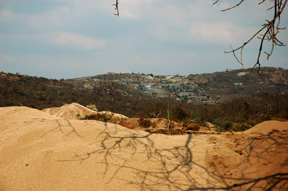
The mine, owned by “Unique Mining,” reached 200 meters into the earth and was accessible through a steep decline using secure ladders and cables.

Our guides, sometimes laughing at how slow we were to descend, and later ascend, were on the other hand quite impressed that we would attempt such a feat in the first place. In the middle of the mine shaft, our group burst out singing “Happy Birthday” for Brett’s 22nd, and our guides chimed in with slightly skewed pronunciation.

Mining, always deemed a dangerous profession, maintains its attraction due to the possibility of getting lucky and getting rich. But for many, it is too hard of a life. Miners spend an average of 10 hours underground each day, with only Sunday off each week. There are two shifts per 24 hours, so there are always people working on the mine. Gear includes a jackhammer, ventilation tube, pick, dynamite… no hard hats, no masks – ten hours a day in a dark, dusty, and very warm and humid hole without any protection. People used to get injured or die frequently from explosions, Benson recalled, but that doesn’t happen as much anymore.

Still the expansive mining shantytown and the aged and wrinkled miners that don’t so easily ride around on their dirt bikes anymore, show that this industry is one that people won’t quit as long as there is money involved.

After two hours exploring the mine, looking at tanzanite veins and picking our other minerals and rocks that accompanied tanzanite, we emerged late in the afternoon to a case of much needed sodas that the owner had brought in for us. Like Benson, this man asked for no compensation, and seemed pleased to take four hours out of his day off to show us a glimpse into his life and that of his employees.

On the way back, we stopped again in town to walk around the streets and see the last traces of the mineral market that was apparently bustling earlier that day. Dirt alleys and streets diced up what seemed like a surreal ghost town, lacking the vibrant colors that have become associated with Africa, with all inhabitants focused on one goal; selling Tanzanite, real or fake. Like usual, locals crowded around us trying to sell what gems were in their pockets and to see the peculiar spectacle: 16 Americans walking through town and covered in black dirt. One old man in particular looked at us wide-eyed when we told him we had just trekked to the bottom of a real mine. I don’t think he ever thought he would see women in such a state.
– Kaia
* TanzaniteOne is a South African mining company that has a monopoly in the tanzanite industry. It is a vertically integrated company and owns a substantial mining area, buys from local miners, refines and cuts gems, and exports them. So far, there doesn’t seem to be too much controversy over the company, despite its monopolistic manner and the newly sparked popularity of tanzanite driving up international market prices. The TanzaniteOne foundation actually claims to do quite a lot of community work in neighboring areas where their workers live, including providing housing, clean water, food and primary and secondary schooling. Their headquarters is the single largest building in the area and their mining buildings stand apart as the only modern construction in the actual mining hills. In terms of working conditions, local opinion claims that they are doing a decent job of conducting responsible business.
A month ago, we gave a loan to Lelito, a non-profit organization located in our neighborhood and that provides a free school for orphans and home based care for people with HIV/AIDS. Yesterday, we visited their organization for the first time to check up on their chicken project that they started from the initial investment of the loan. In a backyard coup, 150 broiler chicks (chickens for consumption, not eggs) have grown to midsize and in another two months will be ready to sell. From this investment, they project they will be able to earn a 3500 Tsh profit (close to $3) per chicken. Projects like these provide the financial support for their main programs as well as gain enough income to repay our loan.
Near the end of our visit, we dropped in on the day care and school yard where a group of children, and later women, surrounded us with song and dance. One girl, the top of her class, told us the story of the school. “We are orphans,” she said. “Our parents died of HIV/AIDS. Some of us are affected with HIV/AIDS… So visitors, please pray for us…”
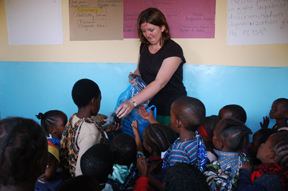
Leslie, an Arusha Project volunteer, who brought an entire suitcase of toys to Arusha with her, handed out toys to all of the school children that day. The moment the toys came out of the bag, hands outstretched and smiles laced the room. A happy meal toy we would take for granted meant the world to each of them.

– Kaia

In the thick of a tropical hillside forest rests a sacred waterfall. Set in a beautiful and lush gorge, the site was traditionally used as a place of sacrifice and worship. On one side, a small fountain of water juts out of a rock wall – it is said to have healing powers, to be the water of God. At least that is what Tom says and this is practically his back yard.
Nearby is a little school, six humble rooms in total (but only three small ones are finished and useable) filled with old rickety benches. This school is Arusha Project Volunteer, James’ placement and in the mornings, he teaches the younger children English.

The school caters to students, age 4 to 30 who come from homes broken by HIV/AIDS. All have lost at least one parent to AIDS and some are living with single parents, grandparents or foster parents. They walk as far as five kilometers with their siblings to attend the free school because they have no way to pay to attend a public school in their home village. The teachers are all practically volunteers and only see a salary if enough funds come in that month. The simple building, the students, the teachers all give meaning to the name Hatuchoki, “we cannot tire.”
Tom, the founder of Hatuchoki, was fortunate enough to be able to attend school up through Standard 4 as well as additional tourism and art courses, so he’s quite well educated. A few years ago, a friend came to him and begged Tom to teach him and help him pass a required test to enter into secondary school and then college, and so Tom started teaching.
In Tanzania, the school system starts with primary school and continues on to secondary school provided students pass an standardized entrance test. Government primary school is taught in Kiswahili and secondary school is in English, however there are private primary schools taught in English that parents can pay to send their children to, so they will perform better when they enter secondary. After that children can take Standard 1-7, each lasting a year, and each more and more tailored to your profession of choice. Standard 7 is actually dedicated solely to learning the tourist industry. The last step is university, although it is a common perception that higher education doesn’t really result in a better life, that there aren’t enough jobs requiring an undergraduate or graduate diploma, and that just being able to negotiate the booming tourism industry is enough.
And so Tom started teaching. Gradually more and more people started asking Tom to teach their children. “When someone comes to you and tells you their story, you can’t say no,” remarks Tom. With a donated class room and a couple benches, Tom built what is now, three years later, the Hatuchoki schoolhouse. As long as children can find a seat in the room, they are welcome to come to school.
Profit, or a living wage is hard to come by here. Tom, a Tanzanite mining veteran of 15 years, gave up the job because it was too dangerous. At the bottom of the mine, Tom recalls, if the oxygen pump machines fail, you die. When he first started Hatuchoki, he still relied on mining to fund his work as a teacher, so when he needed money, he would leave his students for periods of time to go mining, and then return when he was able. Hs students would await his return to commence their studies. Now, Tom sells his art and occasionally works as a driver. He says life here is a day-by-day existence. Most people work very hard just to make enough for a meal. At Hatuchoki, if there is money, it’s used for new benches, desks, teachers’ salaries. If there isn’t any, improvements just don’t get made.
But Tom is a dreamer, and has a seemingly endless list of potential business ideas (like transporting cheap electronics from Dar es Salaam) that he’ll do if, and it is the notorious if, he gets the money to start something. With the projects, he claims, he’ll be able to fund a new schoolhouse and maybe even steady teachers’ salaries.

In the meantime, the school survives and so does Tom. He watches out for his students to whom he imparts his knowledge. He says one day, when he’s old and he can’t work anymore, his students will remember what he did and they will take care of him. Until then, he says to struggle is to gain the education you need to teach others, and it’s these messages of struggle and hard earned accomplishment and opportunity he can pass on to the youth.
-Kaia
Our second round of volunteers have arrived and jumped full swing into their work in different placements throughout Arusha town and the surrounding neighborhoods. The individuals volunteering near the center of Arusha town are dropped off by our dala dala, but those placed in further settings get there independently on the public dala dala system.
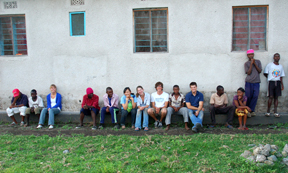
The dala dalas can be a little harrowing at first. Just imagine a small minivan with around ten seats pulling up to you on the side of the road. Usually the van is already packed with quite a few people. While the can is still moving a doorman jumps out, starts yelling the destination in a voice so monotonous and fast that you feel like you are in some bidding room, and starts to corral potential passengers into his car. The first step of success is getting on the right dala dala and finding a seat, the later has a whole strategy attached to it involving comparing the length of your trip with the existing crowd factor and the number of bags you have to maneuver. The second step is not getting ripped off. The doorman, who also collects the fare, often thinks that he has the right to charge what he pleases and getting back the right amount of change can sometimes be quite the hassle. The third step is getting off at the right place. It takes some getting used to, but eventually you realize that you really do enjoy the public transport here. Dala dalas come almost every one to five minutes, they will always find space for to fit you in, they get you to where you want to go relatively fast, and they are cheap. That’s a conundrum for American public transportation, but then again, packing 20 people into the back of a van wouldn’t be all that legal in the States either.
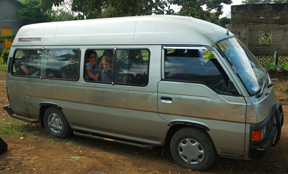
Yesterday, we had almost that many shoved into our Arusha Project dala dala on a ride up to Maji ya Chai. This is our second visit to Tupendane, the partner location to CCF (Children for Children’s Future) and the permanent home for CCF at-risk youth. This time we brought small starter plants with us to fill up the rest of their yard. Their small farm, already flush with cabbage, tomatoes, onions ad a variety of other leafy greens, is used to feed the children living there. With the extra plants we brought, a few tools and some buckets to bring water from a nearby abandoned fishery pond, we were able to plant another large section of their garden with everything from peppers, and eggplant to Chinese cabbage.
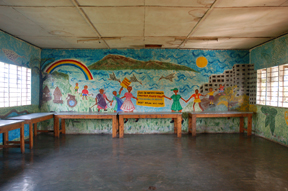
After a few hours of planting and weeding, and a second lunch that the Tupendane cooks kindly prepared for us, the boys started showing off their talents: free styling and acrobatics. It was a good and sometimes comical scene, and they boys, far from humble, showed off to the max. They finished off the day with some entertaining dance moves to the radio music from our dala dala. It’s amazing how people move here, whether they intend to put on a show or they are just following a faint beat, it’s beautiful.
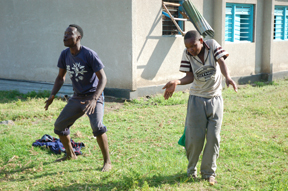
-Kaia
Yes, we still celebrated it, even half way across the world. We organized the festival in our backyard. We invited all of our local partner organizations to attend, as well as artists and performers. Our Tanzanian friends set up their crafts on our lawn and sold everything from Maasai jewelry, African carved wood and fabrics, to locally made natural soap and insect repellant for volunteers to take home with them.
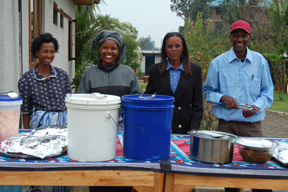
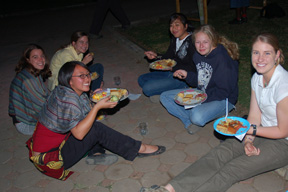
Our chefs and matrons cooked up a huge, delicious traditional Tanzanian meal for all the volunteers and guests, and as the sun set, our performers started their work. First up, a local group of child acrobats jumped on stage doing flips and contortions. Next, a traditional African dancing group accompanied by drummers took the stage with a variety of dances with origins in different parts of Tanzania. The night finished off with a small dance party. Although there weren’t any fireworks, we still had a very lively 4th of July bash.

-Kaia
Earlier this month, setting up the Arusha permaculture project was a bit challenging and took more time than anticipated just find a suitable plot of land and actually sign a contract. As I’ve said before, everything moves slowly here, and business deals are no exception. The plot adjacent to the back of our house that Jenn initially scoped out was perfect and at first the “owners” seemed willing to let us lease it. But, as it turns out, they weren’t the real owners. The actual owners had other aspirations of eventually building on the land, especially since there have been quite a few foreigners that have recently moved into this neighborhood, making the area much more desirable.
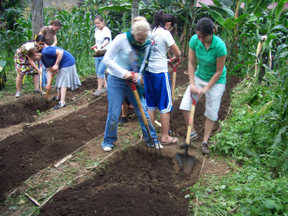
After looking at a few more options, Jenn finally found another plot just around the corner right outside the house of our most trusted maitron. Besides some already planted corn and overgrown weeds, the land is perfect and Valerie has since then successfully signed a land contract for one year with the potential to extend another two years.
In the last three weeks, the volunteers have double dug three large beds with local compost (we are in the process of setting up our own composting site, but we will need some time for our food waste to compost thoroughly) and put in place around 12 fence polls that will hold a 6th tall chicken wire fence to keep the children and the chickens off of the cultivated land.
-Kaia
Aang Sarian Yesterday we visited an incredible non-profit set in the Dodoma region, about a one hour drive from Kwa Idd. The co-founder, Gemma, was the first white person here I’ve seen who speaks Kiswahili fluently and understands a bit of Kimaasai as well. She is married to an equally qualified Maasai man who is also an Oxford graduate and speaks English immaculately. The organization, Aang Sarian, or house of Peace, works with traditional tribes in an effort to educate members on HIV/AIDS and use that as a medium for discussing female genital mutilation (FGM). Initially, Aang Sarian organized various village meetings in which all respected sectors of society (teachers, doctors, elders, etc.) where invited to speak about FGM and what the practice means in Maasai culture.
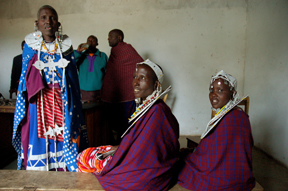
In Maasai practice, young women are traditionally cut in a coming of age ceremony, however the operation is sometimes performed as early as birth for a few reasons. The Maasai perform FGM as a right of passage and a challenge to enter womanhood, to cleanse and purify, to prevent promiscuity and make a woman loyal to her husband, to raise social status, and as a part of a larger ceremony that teaches a girl the intricacies of adulthood and marriage. Aang Sarian’s goal is to remove FGM as a Maasai practice while maintaining and respecting the meaning behind the practice and using alternative ceremonial acts in its place. Individual Maasai man and women are educated on the effects of FGM who then disperse their knowledge among parents, girls, boys, elders and circumsizers so that these people will be approached by people they respect. Aang sarian held a conference to educate 100 ex-circumsizers who will spread the information to their peers. With the help of many Maasai and a culturally sensitive approach, Aang Sarian has developed a modified rite of passage that substitutes the operation with an HIV test (to challenge), a bathe of water (to cleanse), and education about FGM and HIV/AIDS. In this ceremony the money a girl’s parents would have paid for the operation is instead bequeathed to her as a gift. Myths that only a circumsized woman will remain loyal to her husband has been replaced with ideas woman have spoken about; that love and respect will accomplish this goal. Another myth that FGM cures a common female disease has also been disproved by medical science and for the first time, Maasai are actually being incouraged to seek out the aid of doctors and hospitals for serious illnesses and consult their traditional doctors second.
Originally, Aang Sarian was broadly an organization to preserve Maasai culture and was questioned when they adopted an anti-FGM campaign as the practice was inherent in Maasai tradition. However, Aang Sarian has so far done an incredible job of bridging traditional culture and current medical knowledge to create a healthier Maasai community much more adaptable to the changing world environment in which they live.

Aang Sarian is a very young organization, the modified ceremonies have only begun to be advocated this year, but already has established prestigious volunteer opportunities for masters students at Oxford and other top universities. They are currently looking to build a drop in center in Arusha town to target urban Maasai, especially the many Maasai men that work as guards for almost every house in the area. These people are more prone to contract HIV.
-Kaia
Corrections: In alternative ceremonies, the money a woman’s parents would pay to have her circumcised goes to an ex-circumciser who is present to perform a washing (alternative cleansing to substitute for FGM) and give health information about circumcision during the event. Also, Gemma’s husband did not attend Oxford. I apologize for all misunderstandings.
Earlier this week I visited Latoa’s Nursery school where Tammy and Aileen have been volunteering. The school is held in a church about a forty minute walk off the main road and serves orphan children too young to attend public school from the surrounding community. Every day, these children gather from their foster homes at 8:30 AM till 12:00 PM.

When we arrived, the children were already sitting in the pews on one side of the church. Their local teacher began the day with numbers in English, a task that on and off, continued all morning. Tammy and Aileen at first walked around encouraging children to pay attention and doing conflict resolution when a few of the nearly 60 students got a little too ruff with their peers. The children in the front were much more well-behaved but didn’t manage to avoid the teacher’s stick any more than the unruly children in the back of the class. This was the first time I was introduced to use of the stick, which over the course of this week, I’ve come to see as a desired practice among teachers and parents. As I began to follow the teacher’s stick, I began to recognize many more in different shapes and sizes tucked into the backs of pews all over the room. The sticks were used for any number of reasons, most that I didn’t understand or didn’t see the gravity of the situation most likely from the cultural and language barrier. As the class progressed, Tammy and Aileen taught some children beginning math and reading, and participated in activities like the ever popular “Head, Shoulders, Knees and Toes.”
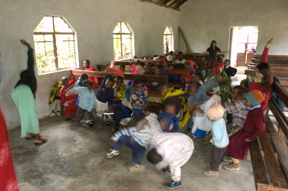
Near mid-morning, after the children had had a slight break, the teacher suddenly decided to take roll, something she had never done in the last two weeks our volunteers were there. It was quite a comical scene actually—60 kids sitting, growing increasingly bored, screaming out “present” just to repeat the teacher or each other. When she got to a little girl in the front, the girl fell silent, and out came the stick again. After softly slapping her and pinching her cheeks, the teacher received a quiet reply muffled by tears. That girl didn’t smile again that day. Roll took nearly an hour, in which resolving fights and consoling crying little ones was our main work. The teacher says since the ugi (the children’s’ daily porridge that serves as a very watered down mid-morning meal) ran out last week, they haven’t been able to buy more and the kids have been unmanageable. They are just hungry, it’s understandable, and sadly it’s not an uncommon situation here.
Teaching is quite a different scene here, and even though the children seem to love to learn, the whole atmosphere around learning is much more strict and rigid than we would tolerate back home. In contrast, teachers’ attitudes towards playtime are much more relaxed and indifferent.
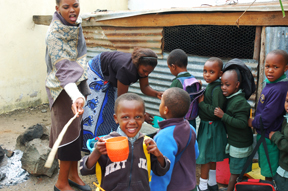
Another of our partner organizations, Women In Action (WIA), has a nursery school that seems to reflect some of the same principles and methods of teaching as Latoa. At WIA, there are three teachers and Lindsay, an Arusha Project volunteer, for about 100 kids. Every day, the children take a Mercedes Benz school bus that mimics an elegant tour bus for 30 minutes from the city centre. The children that WIA cares for are orphans or children of parents who have aids. Some of the children are infected themselves. One little girl kept telling us her wounds hurt, she had spots on her head that were bald and scabbed and she was evidently quite sick.
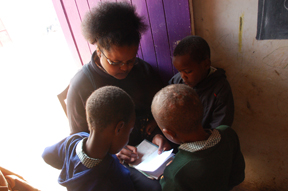
During the morning, Lindsay often takes over the entire class, teaching them vowels, letters, colors, etc. and correcting homework. She works mainly with one a female teacher that she describes as good but tough. Let me give you an example. When asking the kids to get out their pencils, she started yelling to the lagging students, “Show me your pencils or I’ll beat you” (translated from Kiswahili). It’s not a phrase I fully believe she would have followed up on, but it certainly got everyone’s attention. I ever actually saw her use her stick, but Lindsay says it’s not too uncommon. I’ve realized it’s more of a way to gain respect than anything else and the teachers here do know how to make their kids act, although they get their desired results through forceful methods Americans would deem shocking and old fashioned.
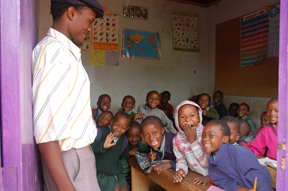
The parents approach learning with little difference. This particular morning, a grandmother dropped off her granddaughter and directly approached Lindsay, asking her to please beat her child so she will improve her studies, as she’s not satisfied with her performance. It was a bit shocking and gave us a little more insight into what happens to some of these kids at home.
However, WIA was also the first place I saw a teacher be actually kind and caring. The male teacher was probably the most gentle man I’ve met here, and the older female teacher was an incredibly nurturing character. I have no doubt that they too follow the cultural norms of teaching, but balance the stick with love and encouragement.
-Kaia
Thursday and Friday marked the training and dispensation of our loans to 50 individuals and 4 NGOs that Cheryl (our microfinance specialist) carefully selected based on feasibility and accuracy of business proposals from individuals and organizations affected or infected with HIV/AIDS. In a conference hall in the center of town, these women (and a few men) met for two days in a row to take a training course on business and entrepreneurship. The process was not without a few bumps along the way.
Earlier this week we found out that an organization we work with, but that we had not decided to give loans to, had taken out radio time to advertise out loan program and the training program we hosted this week, so on Thursday morning, women not selected for loans or invited showed up, media representatives came, and some of the women the program was targeting did not show up. Friday seemed a little more organized and by mid-afternoon we were ready to start the process of actually giving out the cash loans. Out volunteers stepped in to survey the living situations of the women. Questions were used to determine food consumption patterns, housing types, expenditures and monthly income to measure the women’s standard of living, which will then be compared to the same statistics taken at the end of the program to assess how effective the program was at changing the participants’ quality of life. Cheryl formulated our microloan program in the style of the Grameen bank where women choose their groups of five individuals and jointly assume responsibility for paying back the loan with interest in full. If one woman fails to perform the others are held accountable for paying her portion. This system encourages women to pay back their balances through peer pressure and responsibility to their trusted friends. In groups of five, women approached out loan table, each group accompanied by a trusted head of an Arusha Project partner organization, which the women are members of. We wanted the organization heads to be present to testify that these women are who they claim to be. Still, we had doubts about many of the women as their ID cards did not match the names on the list and a few did now have any form of identification at all. Often women presented medical cards that they acquired when they were tested for HIV, and apparently no one gives their real name when they go to get tested as such a huge stigma is attached to the disease. It’s not a surprising situation but it made our job much harder. Often Cheryl would resort to asking the women what their proposals were and if they could sign their names correctly, as alternative questions to judge if they were telling the truth or not. When asked to sign their names, we found that illiteracy far from uncommon and the basic task of signing one’s name can be one of the hardest things for some of these women to do. Eventually all the selected individuals received their pre-specified loans and one group even declined to take their loan asking for a short extension to think about the feasibility of their repayment schedule.
We are hoping to have a 70-75% success rate on these loans, but it is a pilot project as no one has really targeted the HIV/AIDS community in the microfinance sector. Small loans, officially used to help the poor raise themselves out of poverty through facilitating an income generating practice, rarely target the poorest of the poor, and look for individuals that have more potential business skills or collateral and have shown their ability to repay loans through previous practice. Here, we are targeting a sector that is notoriously the most impoverished and socially shunned as well as more susceptible to common diseases. The hope of the Arusha Project microfinance project is that because of their condition, these women will realize the great opportunity they are given, be pushed by their peers to produce, and want to return their loan so that the program can grow and help more of their neighbors and friends in the future rounds to come. The future of this project, or lack there of, essentially lies in the hands of these 50 women.
-Kaia

